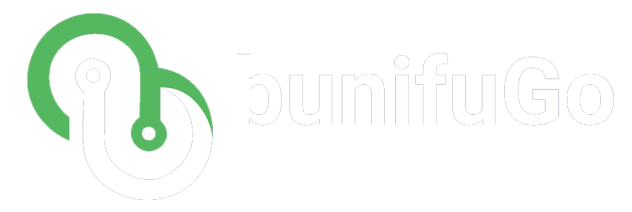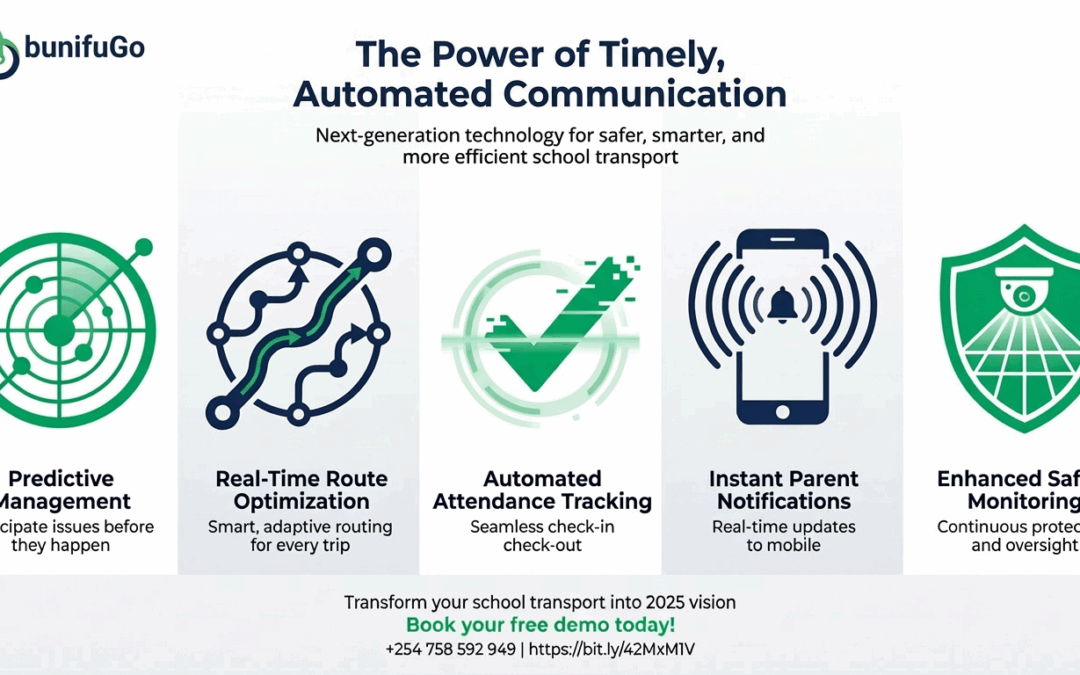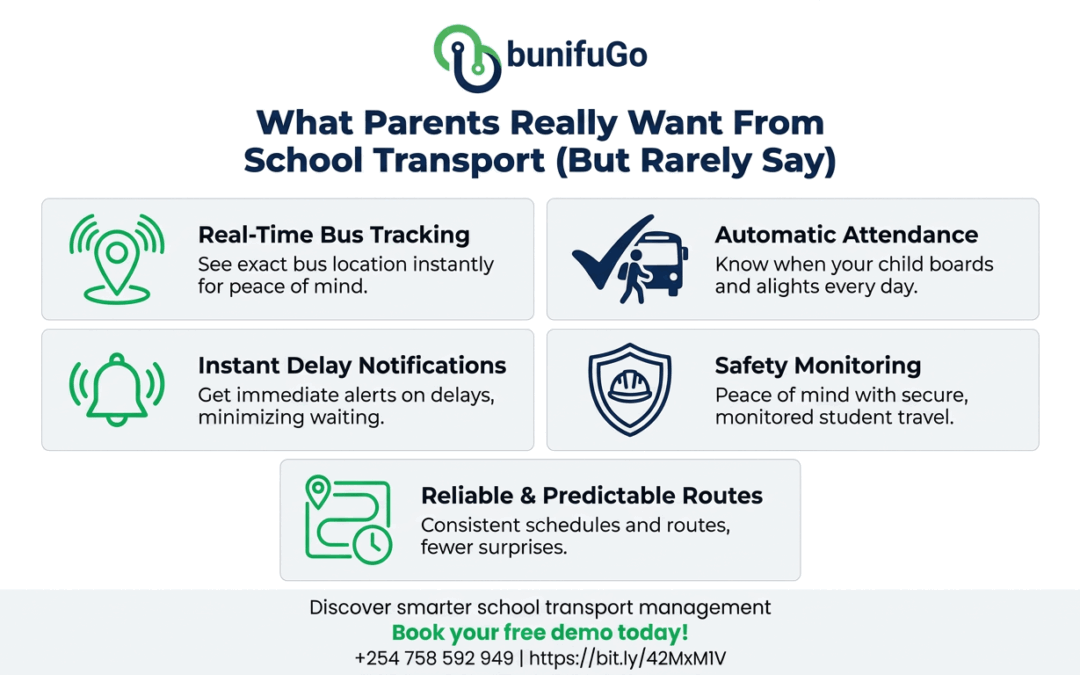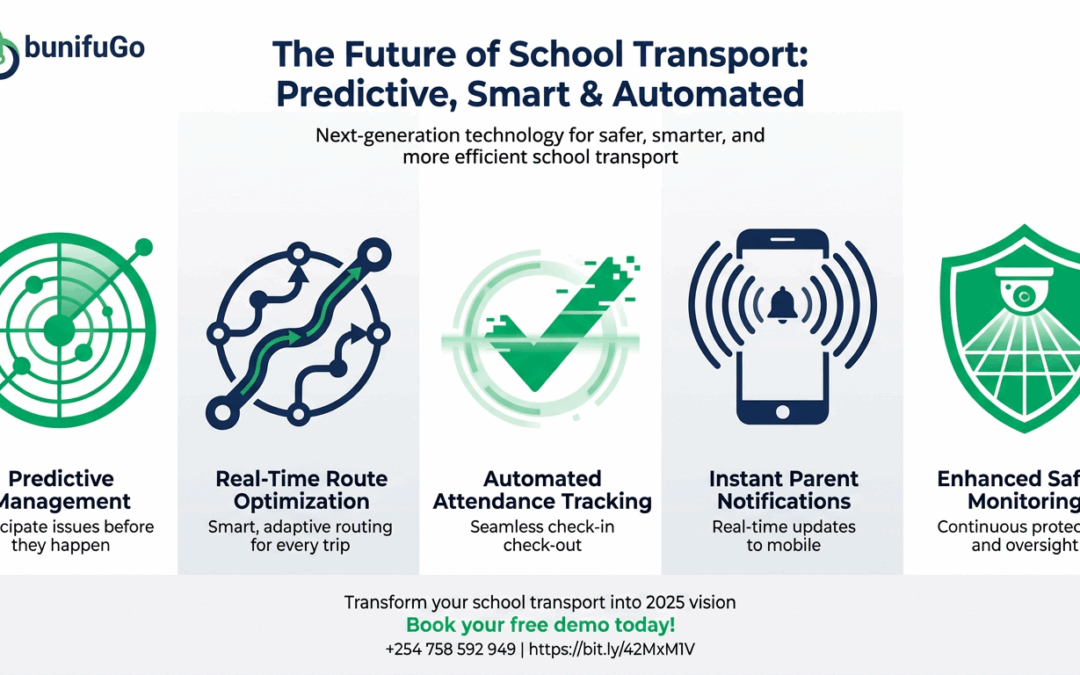Introduction: Beyond the Initial Investment of a School Transport Management System
In Kenya’s rapidly evolving educational landscape, school administrators face increasing pressure to balance quality services with financial sustainability. School transportation—a critical service for thousands of families—often represents a significant operational expense that many institutions struggle to optimize. While the upfront costs of implementing a school transport management system like Bunifu Go may give some school leaders pause, a thorough return on investment (ROI) analysis reveals compelling long-term benefits that extend far beyond simple cost reduction.
This article explores the comprehensive ROI framework for evaluating transport technology investments, helping Kenyan schools understand the true value proposition beyond the initial price tag. From quantifiable cost savings to intangible benefits that enhance school reputation and parent satisfaction, we’ll provide you with the tools to make informed decisions about school transport management system implementation.
Quantifying Direct Cost Savings
Fuel Economy Through Route Optimization

Perhaps the most immediately measurable benefit of implementing a transport management system is reduced fuel consumption. Studies across educational institutions that have implemented route optimization technology show fuel savings ranging from 15-25%, depending on prior route efficiency.
Maintenance Cost Reduction
Preventive maintenance scheduling and driver behaviour monitoring have been shown to reduce maintenance costs by up to 30%. A school transport management system extends vehicle lifespan and minimizes costly repairs by detecting aggressive driving patterns (harsh braking, rapid acceleration, excessive idling) and ensuring timely service intervals.
For example, a school operating ten buses might previously have spent KSh 1,200,000 annually on maintenance. A 30% reduction represents KSh 360,000 in annual savings—funds that can be redirected to educational programs or facility improvements.
Administrative Time Efficiency
Manual management of school transport operations—including attendance tracking, route planning, parent communication, and billing—typically consumes 15-25 hours weekly of administrative staff time. Automated systems reduce this burden by 70-80%, freeing staff for more value-added activities.
For a typical school, this translates to approximately 800 recovered administrative hours annually. Assuming the average administrative hourly rate of KSh 300, this represents KSh 240,000 in productive capacity redirected toward core educational objectives.
Evaluating Indirect Financial Benefits
Increased Transport Service Enrollment
Schools reporting enhanced transport safety features and real-time tracking capabilities frequently see increased enrollment in their bus services. Parents who previously drove their children to school or arranged private transportation often switch to school buses when safety and transparency improve. One Nairobi-based school reported a 22% increase in transport service enrollment within six months of implementing comprehensive transport management technology.
Reduced Insurance Premiums
Insurers are increasingly recognizing the risk-reduction benefits of a school transport management system. Schools with documented safety protocols, driver monitoring systems, and incident tracking capabilities can negotiate premium reductions of 5-15%.
For a small to medium-sized school fleet, this might represent KSh 50,000-150,000 in annual savings, further enhancing the ROI calculation.
Marketing Advantage and Enrollment Growth
In competitive educational markets, safety innovations serve as powerful differentiation points. Schools showcasing a school transport management system and technologies in their marketing materials report that prospective parents frequently cite these safety measures as decision factors when choosing between institutions.
A 3-5% enrollment increase, attributed partly to enhanced safety perception, can generate millions in additional annual revenue, dwarfing the initial technology investment.
Beyond Financial Metrics: The Intangible ROI
Parent Satisfaction and Retention
When surveyed about factors influencing school selection and retention decisions, parents consistently rank safety among their top three concerns. Schools implementing comprehensive school transport management systems report measurable improvements in parent satisfaction metrics, with one Kenyan school noting a 35% reduction in transport-related complaints after implementation.
Improved parent satisfaction directly impacts retention rates, with the lifetime value of a retained student typically exceeding KSh 1,000,000 in tuition and ancillary revenue.
Staff Satisfaction and Productivity
Transport staff—including drivers and bus monitors—report higher job satisfaction when supported by technology that clarifies their responsibilities and recognizes their performance. Schools implementing comprehensive school transport management systems report reduced turnover among transport staff, translating to savings in recruitment, training, and quality of service.
Reputation Enhancement and Brand Building
Perhaps most difficult to quantify—yet potentially most valuable—is the reputational enhancement that accompanies visible investment in student safety. In an age of rapid information sharing through social media and parent networks, a school’s reputation for technological innovation and safety consciousness creates a halo effect that benefits recruitment, fundraising, and community relations.
Calculating Your School’s Unique ROI
While industry benchmarks provide useful references, each school’s ROI calculation will be unique based on:
- Current inefficiencies: Schools with highly manual processes and suboptimal routes will see greater immediate returns
- Fleet size: Larger fleets typically yield higher absolute savings, though even small operations benefit substantially
- Implementation scope: Phased approaches may yield more gradual returns but can reduce implementation risks
- Existing infrastructure: Schools with established technology infrastructure may see lower implementation costs
To calculate your school’s specific ROI, gather baseline data on:
- Current monthly fuel consumption
- Maintenance expenditures over the past 12 months
- Administrative hours dedicated to transport management
- Transport-related parent complaints and incidents
- Transport service enrollment as a percentage of total enrollment
These metrics provide the foundation for calculating both immediate returns and long-term value creation.
Implementation Strategies for Maximizing ROI
Phased Rollout Approach
Rather than implementing all features simultaneously, consider a phased approach that prioritizes high-impact modules:
- Phase One: Route optimization and GPS tracking (immediate fuel and time savings)
- Phase Two: Student attendance tracking and parent notifications (safety enhancement and parent satisfaction)
- Phase Three: Fleet maintenance management and driver behavior monitoring (long-term cost reduction)
This approach allows for early wins that build support while distributing costs over multiple budget cycles.
Staff Engagement and Training
Technology implementations fail most commonly due to inadequate staff training and buy-in. Allocate sufficient resources to comprehensive training programs and create incentives for staff who champion technology adoption.
Data Collection for Continuous Improvement
The long-term ROI of transport technology depends on continuous refinement based on operational data. Establish clear protocols for data review and improvement cycles to ensure ongoing optimization.
Making the Decision: When to Invest
For most Kenyan schools, the decision timeline for school transport technology implementation should consider:
- Budget cycles: Align major technology investments with annual budgeting processes
- Academic calendar: Implement during holiday periods to minimize disruption
- Growth plans: Coordinate with anticipated enrollment increases or fleet expansions
- Regulatory changes: Anticipate and address evolving safety requirements
With typical payback periods of 12-18 months for comprehensive implementations, schools should view school transport management system not as an expense but as a strategic investment in operational excellence, safety enhancement, and parent satisfaction.
Conclusion: Beyond the Balance Sheet
While financial calculations form an essential component of technology investment decisions, the true ROI of transport management systems extends far beyond the balance sheet. The enhanced safety, improved parent experience, and institutional reputation benefits create value that compounds over the years, establishing technology-enabled schools as leaders in both educational excellence and operational innovation.
For forward-thinking Kenyan schools, the question is no longer whether they can afford to implement transport management technology, but whether they can afford not to as parents, regulators, and competitors raise expectations for safety, transparency, and efficiency.
Ready to explore how Bunifu Go can transform your school’s transportation operations? Contact our team today for a personalized ROI analysis and implementation roadmap tailored to your institution’s unique needs.




